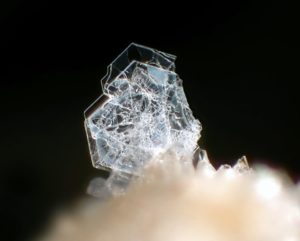
The mineral tridymite is a very rare polymorph of the mineral quartz. It is grouped with silica and tectosilicates. Tridymite is knowns for its unusual crystals which are small and appear as thin tabular plates. They usually form small growths of two or three thin individuals, forming unusual and distinctive twins or trillings. Tridymite can occur as small grains as well as complex icicle-like formations. Tridymite crystallizes at low pressure and high temperatures in excess of 1,472 degree F. As far as we know, it is only associated with temperatures and conditions seen in silicic volcanism – volcanoes with magma containing a large proportion of silica.
For the past few years, the Curiosity rover has been exploring a crater on Mars. Just last year in 2015, the rover was exploring an area called Marias Pass. The rover drilled into the surface of Mars and found something entirely unexpected, the tridymite mineral. The rover used its laser-firing instrument to examine compositions of samples using the Chemistry and Camera (ChemCam). An analysis of this find was recently published in the Proceedings of the National Academy of Science can change our entire understanding of Mars’ history.
The volcanic processes seen in silicic volcanism occur as a result of plate tectonics and flowing water on Earth, neither of which are found on Mars. It is now a possibility that Mars had much more water on its surface than previously thought and it was a much more geologically active planet. The scientific community will now be involved in studies that analyze ways on how tridymite can form on a geological level in a basaltic environment with lower temperatures.






